Optoma UHD30 Reviewed at $1,250.00
Product Name: Optoma UHD30
Product Description: 4K DLP Projector
-
Design - 9/10
9/10
-
Video Quality - 8.8/10
8.8/10
-
Ports & Connectivity - 9.2/10
9.2/10
-
OS, Apps and Features - 8.3/10
8.3/10
-
Price / Quality - 9.6/10
9.6/10
Summary
Reviewed at $1,250.00
Pros
- Extremely sharp 4K images
- Very good out of the box colors
- Low input lag
- Amazing price for 4K
Cons
- Mediocre black levels
- Pixel shifting is turned off with Game mode
- HDR performance could be better
- 240Hz refresh rate is limited to 1080p
Cheapest Places to Buy :
*We are a reader-supported website. When you buy through links on our site, we may earn a small affiliate commission at no extra cost to you. Home Media Entertainment does not accept money for reviews.*
When we are talking about low cost 4K projectors there are bound to cut corners in order to meet the lower budget limitations. Either it be brightness, color accuracy, black levels or contrast these projectors always make compromises in certain specs. But to combat this we have seen manufacturers offer the same models but with different strengths, usually one focusing on colors and the other on brightness giving the power of choice to the consumer. In our Optoma UHD30 review we will be looking at a similarly low cost 4K projector but this one seems to follow a different route.
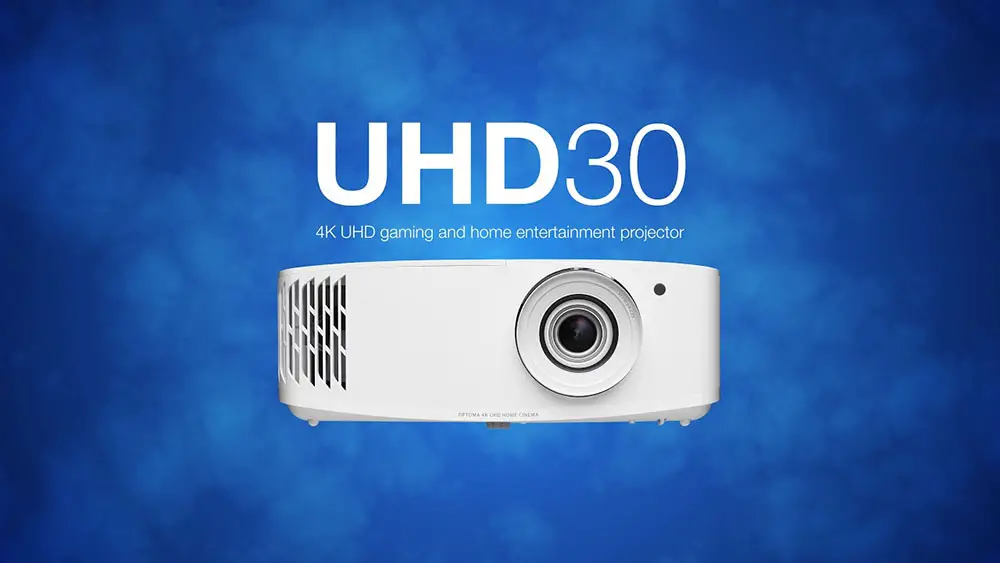
In essence the UHD30 we have here today is remarkably similar to the UHD50X (or UHD42 in Europe) that we had previously reviewed. Upon a quick look at the specs reveal very small differences and these doesn’t have to do either with the colors or the overall brightness that we initially thought of. Basically the difference here is that the UHD30 has higher throw ratio, smaller zoom and no vertical shift. To be honest we were a bit puzzled why Optoma would release a projector so similar to the UHD50X which can add more confusion to the end user.
As with its bigger brother the UHD30 is advertised as a gaming projector, one that can achieve 240Hz refresh rate. While this may seem impressive on the marketing material you will see that things are slightly different in reality. As for everything else the projector is using DLP technology and 4K pixel shifting in order to create a 4K image. There are not many extra features to play with and it seems that Optoma focused entirely on its image properties but with a price of $1,250 you shouldn’t be asking for much more.
The UHD30 costs around $350 less than its bigger brother, the UHD50X. So with this in mind we keep thinking if their differences are significant enough to justify this price gap and if in the end the UHD30 is a better proposal to go with? Keep reading to find out…
Design
With all the different names many similar projectors have in various markets its a relief to see the UHD30 keeping its code name across the globe. Unlike the UHD50X which you could find in Europe as the UHD42 instead, the UHD30 is the same in case you are interested.
As for its design Optoma went for a more or less simple design with very light curves. The UHD30 comes in a white boxy design with rounded corners and it looks almost exactly the same as the UHD50X. There is no difference in shape, size or general layout and to be honest it will be hard to distinguish between the two except from a small detail that we will talk about. As for its size, measuring 12.4” x 4.6” x 10.6” (315 x 118 x 270 mm) and with a weight of just 8.6 lbs (4 kg) it just shows that this was indeed designed with gaming in mind as it’s pretty small taking into consideration some other 4K projectors.
White is the primary color being used and frankly the only one which may seem slightly monotonous to some. Plastic is obviously the main material being used but it looks pretty sturdy even if not the highest of quality. Its surface is using a mixture of glossy and some short of textured parts which adds positively to its looks but nothing that will wow you obviously.
The UHD30 is using an asymmetrical design with the lens being placed on the right side of the front face with a small IR receiver siting just next to it. A completely white focus ring has been placed around the lens which is typical and fits the design and color of the rest of the body.
Ventilation is pretty good as the whole right side, as we look the projector from the front, is being used to let cold air in while on the left front corner there is where the hot air comes out. In general a pretty standard cooling solution that keeps the projector at normal temperatures.
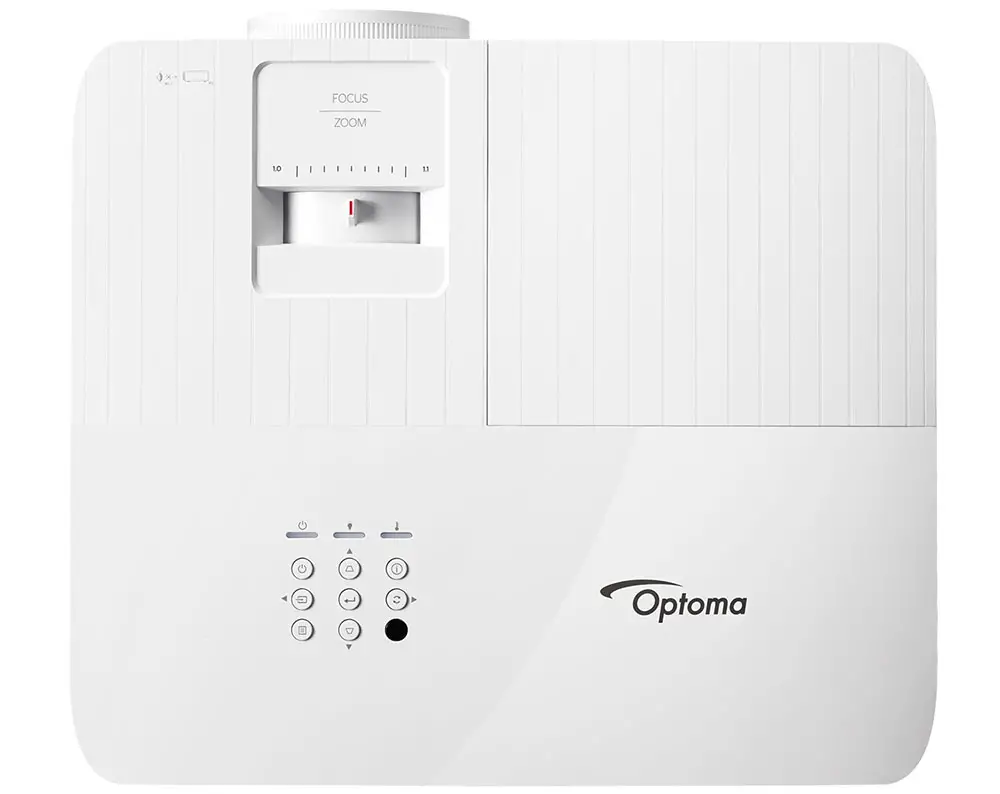
On the top side, exactly above the lens, we find the controls for the zoom which gives the projector a 1.1x optical zoom. And here is one of the main differences with the UHD50X as that one not only gives you a higher 1.3x zoom, it also has another dial offering 10% vertical offset which is completely absent here. This means that in terms of positioning and initial setup the UHD30 gives you slightly less freedom to play with.
At the top side we also get the built-in controls which feature a pretty standard layout. An array of eight circular buttons is complemented by three LEDs on top indicating various projector functions with the first being the on/standby LED, the second being the lamp condition LED and the third the temperature LED.
The available buttons include a central Enter key that is surrounded by the up, down, left and right keys for menu navigation. The up and down keys also act as the keystone correction buttons while the left button acts as an input source selection and the right as a re-sync key also. Top left is the power button, top right the Info button, bottom left the main menu selector and on the bottom right we find the second IR receiver in case you plan on putting the projector on the ceiling.
At the back we find all the connecting ports grouped together and we will talk about them in the appropriate section below. The UHD30 is using three, one at the front and two at the rear, tilt-adjustment feet in case you plan on putting it on a furniture and want some easy and fast placement calibration.
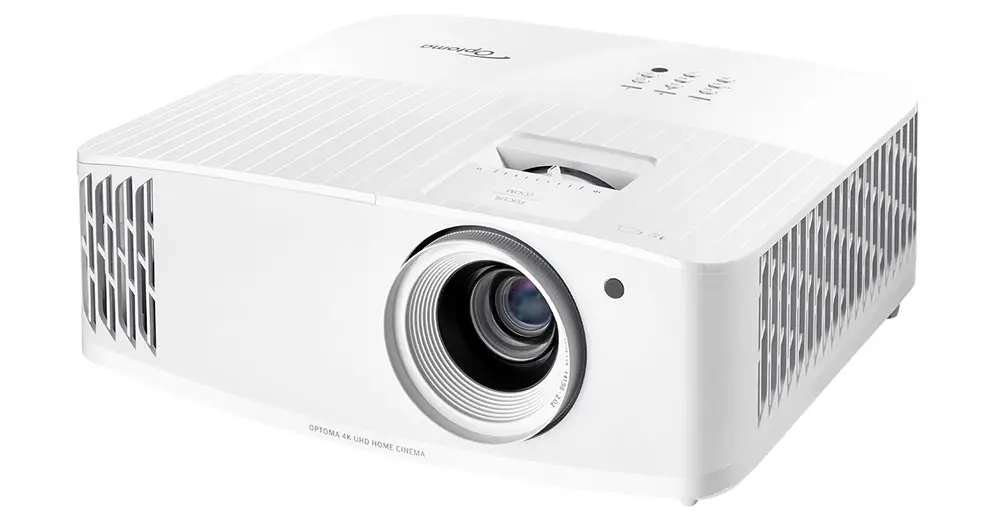
As for the lens that is being used, the UHD30 has a throw ratio of 1.5:1 ~ 1.66:1 with a projection distance of 47.64″ – 389.76″ for a 33″ ~ 300″ diagonal image size. From these numbers you see that the UHD30 is slightly worse than the UHD50X and you will have to place the projector further away to achieve the same screen size. If you have plenty of room space then this shouldn’t be a problem but if you are limited by it then the UHD30 may create problems placing it correctly.
Optoma has officially rated the UHD30 noise levels at 26 dB and while this is not mentioned by Optoma this noise usually refers to its Eco mode. If Bright mode is used this usually get closer to 30 dB or even higher depending on ambient temperature also. Noise is usually comes from two sources in these projectors. The cooling solution and the 4K pixel shifting technology. That’s why usually these projectors are slightly louder than native 4K ones.
It’s not very bothering but if you are very noise sensitive you may want to try them out first because the UHD30 may be slightly audible when in silence as a low pitched sound can be heard. During our testing we could hear the projector in most cases when displaying 4K material but if it frustrating or not it’s up to you to decide.
When it comes to the projector’s lamp life we don’t find anything out of the ordinary also. A 240 watts lamp is being used that can give up to 4,000 hours in Bright mode which extends to 10,000 hours in Eco mode and even can go as high as 14,000 hours in Dynamic mode.
Lastly we should mention about the included remote which seems to be exactly the same that we saw in our UHD50X review. Its design, unlike most simple remotes, is more practical as it gets thinner in the middle for easier grip while its buttons are big enough and have a nice rubber feel to them making them easily distinguishable. The biggest advantage of the remote is obviously its backlight function which is very useful if you tend to use it in a complete dark environment.
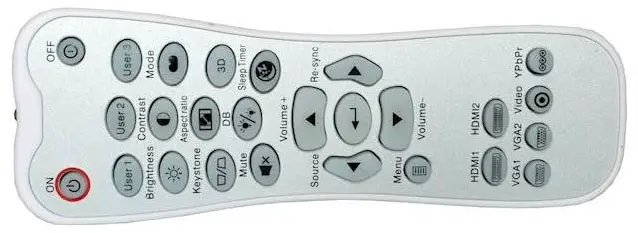
As for it’s functions it has buttons for all the basic features that you can use like brightness, contrast, keystone correction, input selection, user and image modes among others while for the most advanced settings you will have to use the projector’s main menu. Overall it’s one of the better remotes we have seen in this low cost category and we like that Optoma continues to use it among their new releases.
Overall the UHD30 seems to be a slightly altered version of the UHD50X. Build quality is good enough and we just miss the vertical shift dial which the projector has none. Nothing else is different in terms of actual design and construction.
Video Quality
Technology used
In terms of the technology that powers the UHD30 things are exactly the same as in the Optoma UHD50X/UHD42 that we had recently reviewed. This means that under the hood we find a single 0.47″ 4K UHD DMD DLP chip from Texas Instruments that is responsible for displacing a full HD 1080p image in four different positions at very high speeds in order to produce the full 4K image that is very close in clarity and quality to a native 4K image.
For those that don’t know what pixel shifting is, it was created by manufacturers in order to bring down the cost of 4K projectors by offering similar quality at sub-$2,000 levels. Nowadays we have 4K pixel shifters that are even close to the $1,000 limit so compared to a $5,000 native 4K projector the price difference is huge. These pixel shifting projectors are usually distinguished in two different categories depending the type of pixel shifting technology used. There are projectors that shift the image only in two positions and these use slightly larger chips and are a bit more expensive while those that use the 1920 x 1080 x 4 technology tend to be cheaper without any meaningful loss of quality.
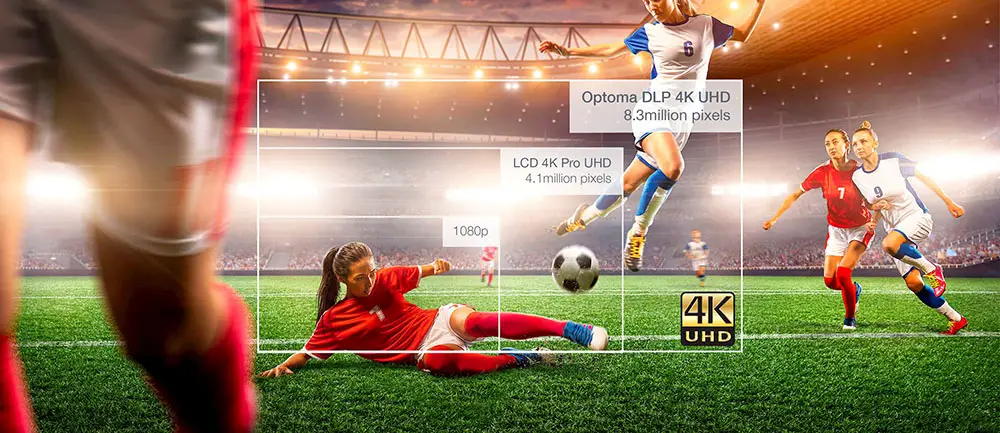
But Optoma has not only relied upon this technology in order to get the best out of their units and as such we also find their own UltraDetail technology. Complex algorithms detect each frame and improve image sharpness before the frame is projected. This technology ensures all the information contained in an image is accurately reproduced on the screen to give the best possible 4K outcome.
In general if you are considering a 4K projector but you are unsure about going for a pixel shifting unit we would say that its main strength is offering very close quality to a native 4K model but at a fraction of the cost. So if you are worried about your budget a pixel shifter is ideal and you get a lot of value for money. If there is one weakness these type of projectors have is that due to the high speed of the shifting technology noise is always higher than native 4K projectors so it’s always advisable to make a test hearing by yourself to determine if it bothers you or not.
4K UHD / HDR Content
For our 4K HDR test we tried Valerian and the City of a Thousand Planets in 4K UHD and since this is a film that exhibits very bright highlights and vibrant colors it was exactly what we needed for this review. Now if the similarities between the UHD30 and UHD50X were anything to come by we were expecting to see similar behavior here.
There was an amazing amount of depth and clarity in the 4K image at hand and it’s exactly what we have come to expect from these low cost DLP offerings. If there is one aspect these always excel at is at image sharpness, resolution and clarity and the UHD30 hit all the right points. Colors were almost three dimensional with excellent vibrancy and good accuracy while even the tinniest of details were visible on any kind of surface either solid or organic.
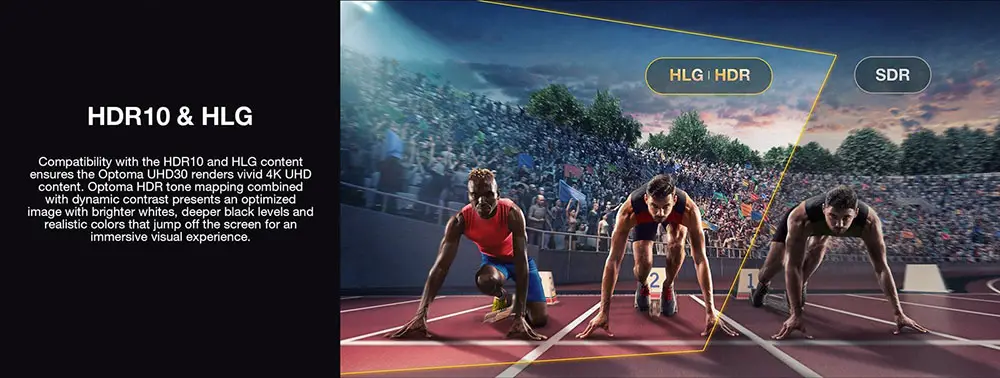
The UHD30 managed to showcase good brightness which is even more impressive if you think about how much it costs. This may be a gaming projector but it can be used for movies just fine as the UHD50X did. HDR may not be the cup of tea for any projector and certainly the UHD30 cannot showcase highlights that pop like a high tier TV can but for what it is, it will give you a fairly satisfactory result. Lower the ambient light in the room and you will get even better results.
In terms of contrast ratio Optoma is rating the UHD30 at 500,000:1 with Dynamic Black enabled. Dynamic Black is Optoma’s feature that works like an auto iris but obviously it has certain disadvantages compared to a real one. Dynamic black cannot make quick changes to the light output and the end result is not as obvious as an iris can do. All these low cost projectors suffer from mediocre black levels so having this Dynamic Black mode certainly helps a lot this projector to somewhat improve its weakness even if the improvement is not as huge as we would like.
When you are watching HDR content the projector will switch to the appropriate HDR display mode and from there you can decide which HDR picture mode you like the most. Optoma offers four different modes with Detail, Film, Standard and Bright the ones available. From what we saw the Standard setting is a good option to choose but if you find the image too dark you can go for the Bright mode instead.
Lastly we should mention about the projectors HDR protocols support which is pretty standard among most projectors nowadays either cheap or expensive. As such we get the HDR10 which is the basis for 4K UHD playback along with HLG which is used for broadcasting. No Dolby Vision or HDR10+ here but with most projectors having limited brightness capabilities there is not much to be missed by these two.
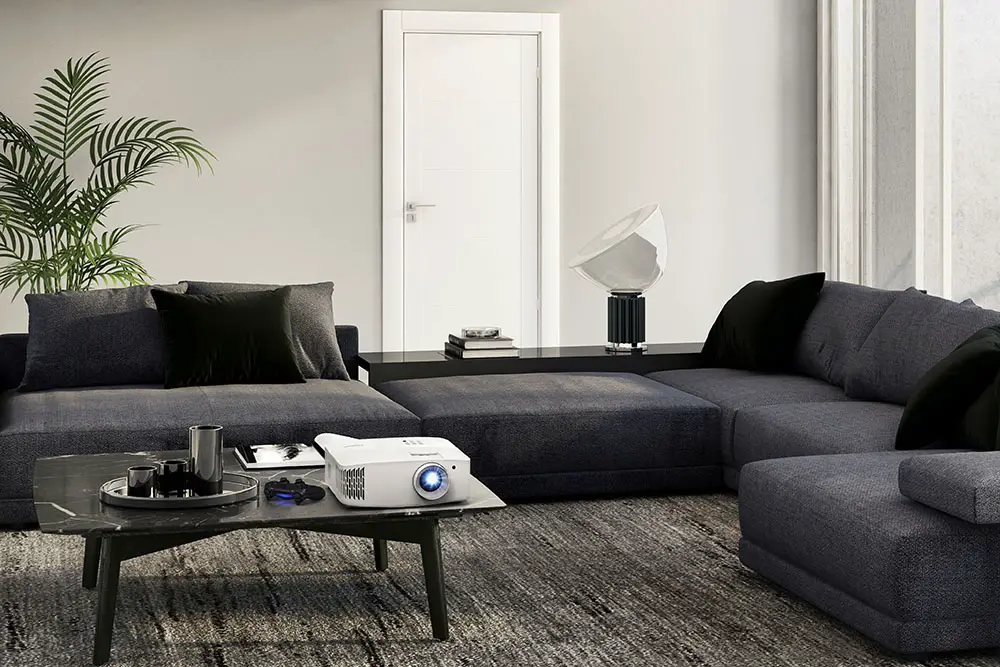
Full HD / SDR / 3D Content
When it comes to our Full HD projectors testing we tend to use a single movie and this is no other than Oblivion in Blu-ray format.
It’s impressive that a 4K projector dangerously approaching the $1,000 price mark can achieve this kind of clarity and image resolution. Everything on screen had excellent sharpness and this helped all details come forth either it was imperfections on the actors skin or the composition of certain surfaces and textures. Colors was pretty accurate without any major calibration which will be greatly appreciated while black levels were obviously its weak spot even with the Dynamic Black enabled.
As we did in our UHD50X review we did try out the UltraDetail and BrilliantColor features that Optoma offers and we could say that, in a similar fashion, for UltraDetail we would keep it to a minimum level or turn it off completely as it can introduce undesired noise to the image. As for BrilliantColor we would recommend a medium setting as higher values are mostly suited only for rooms that have excessive light.
Generally we would say that the UHD30 fared pretty similar to the UHD50X in our tests while showing the same weaknesses we have seen in most low cost 4K DLP projectors and this is no other than the average black levels they can output. For casual users and those that are not particularly demanding will find the black levels performance good enough, and some ambient light can certainly help with that, but if you are particularly picky then you will have to check a more expensive category to get any significant upgrade on this area.
Lastly we should not forget to mention that the projector also supports 3D. This may be a dead format for TVs but it has certainly found its home with projectors. The UHD30 had no problem with 3D content and when the appropriate signal was detected the projector switched automatically to the 3D mode. We didn’t observe any major artifacts or crosstalk but brightness, as with all 3D content, takes a major hit. To view 3D content you will need to use DLP Link active shutter 3D glasses that unfortunately are not included with the projector.
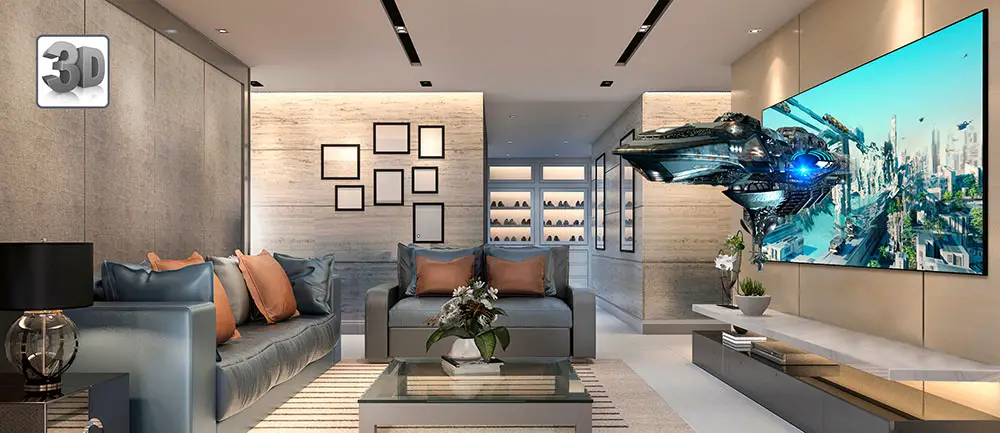
Color Coverage
In terms of color performance the UHD30 is using a similar 8-segment color wheel that we had seen in the UHD50X with two sets of red, green, blue, and white segments. There is no extra wide color filter included here as this we usually find in more expensive models but the projector with its RGBWRGBW color wheel still manages to support wide color gamut.
As we usually do, we will talk in more detail about the available color modes in our next section of the review but in terms of color performance and accuracy we would suggest you to use the Cinema mode as this seems to be the best overall with color reproduction, smooth gradients and color volume.
The projector can give pretty good results without the need for very deep calibration which surely will be appreciated by many that just want to set this up and forget. And while there will always be those that want to tweak every last bit of their projector many casual users want to spend as little time as possible in order to get the best out of it. And the UHD30 is such one.
One last thing to mention here is that as with all projectors that use color wheels there is a chance that you will be prone to see a rainbow effect which can be bothering to some. Not all people can see it and certainly it was not something we saw but some small percentage can see it and can be really bothering so make sure you are not prone to this or at least make sure you make a test run before purchasing in order to determine if it is a problem in your case or not.
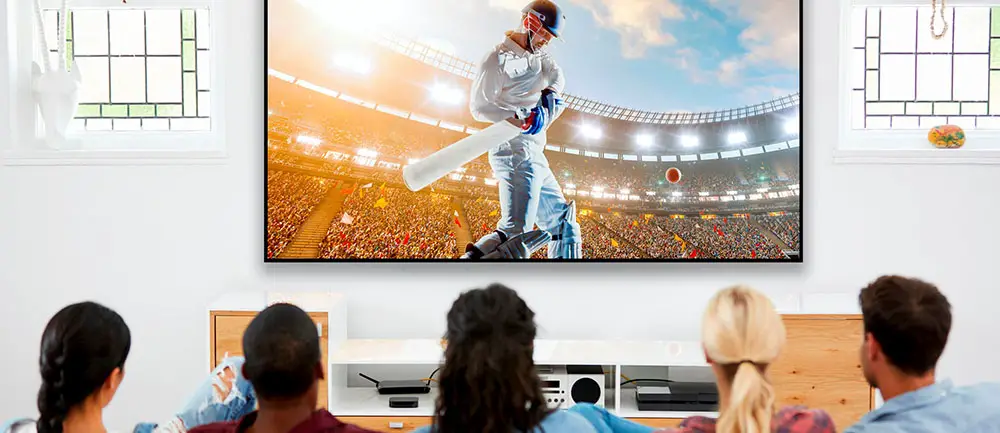
Brightness / Picture Settings
The UHD30 is rated as a 3,400 lumens projector and we were curious to see if the unit would perform similarly to the UHD50X as they are practically the same in this regard.
Keep in mind that there are many factors that can affect brightness on a projector so the numbers we give are only for giving you a general idea of the projector’s capabilities and yours may differ in the end. When watching SDR content the available modes include Bright, Cinema, HDR SIM, Game, Reference and a User defined. The other modes like 3D, HDR and HLG are used automatically if the appropriate signal is detected. There are also ISF Day, ISF Night and ISF 3D so you can save different settings as you please.
As always we use the widest angle along with Bright mode in order to get the maximum brightness and in this case we got 2,714 lumens. And while this may be the most bright it certainly is not the most accurate as it was slightly on the green side as it happens with the brightest mode in most projectors. Cinema came in second with 1,258 lumens but had much more accurate colors to begin with while Game and HDR SIM were pretty close at 1,070 and 1,012 lumens respectively. Reference came in last with 574 lumens of brightness.
For HDR mode we got 1,374 lumens which is not bad either but you don’t have much choice there as the HDR mode is engaged the moment it detects an HDR signal. As for SDR content we would recommend the Cinema mode as it came with the best out-of-the-box performance in terms of color reproduction.
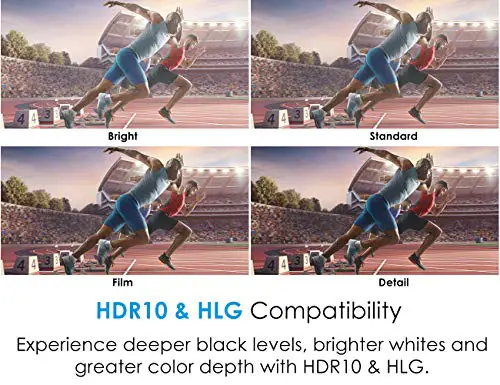
Black Levels / Contrast
Being a low cost 4K pixel shifter we were expecting the UDH30 to have less than stellar black level performance, similar to what we saw in the UHD50X and it seems that we were correct. Unfortunately you will have to go to a more expensive category in order to find a projector that can give you deeper blacks than what we usually find here. It’s not an all out disaster of course and depending on the room light conditions things may be better than you may think.
Keep in mind that if a projector cannot display very deep blacks in a dark environment this will be much more evident than it would in a well lit room. The more light you add to the room the less this weakness will show. And since the UHD30 is advertised as a gaming projector it means that more than certainly you will have some ambient light in the room when in use so while the problem is still there it wont be so much visible.
Also while the projector is missing a true dynamic iris the available Dynamic black mode can help a little with black levels and can certainly improve the image in a completely dark environment. With the Dynamic black mode enabled Optoma claims a 500,000:1 contrast ratio but we did notice something that we also observed in the UHD50X. While using it the fan of the projector would change speed depending on the how bright the lamp was. And with the projector being already a bit too loud this change of speed may distract some especially when the room is mostly quiet. It’s not a huge problem, but it’s audible and may be frustrating to some.
No surprises to be honest here. These cheap 4K DLP pixel shifting projectors always had problems with deep black levels and the UHD30 is no different. For someone that is not nitpicking you will find the blacks just fine, just don’t have extreme expectations in this price range.
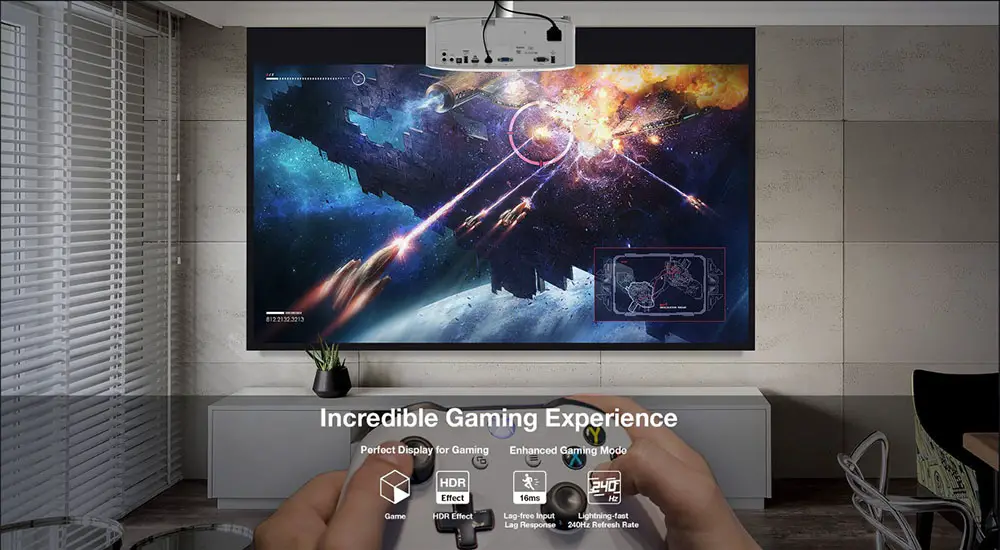
Input Lag
In all these gaming projectors Optoma has released like the UHD30 and UHD50X the input lag seems to be the most interesting part (along with motion performance that comes next) since this section will interest mostly those looking at such a unit for their gaming pleasure. Now there are a few things worth mentioning here and the first one is that while the projector is being advertised as having very low input lag this still is much higher than what even low tier TVs can do nowadays.
We have seen even the cheapest TVs from the big manufacturers offer as low as single digits input lag something that is impossible even for a true gaming projector. But in general we tend to agree that anything under the 30ms mark can be considered very good for any projector that is intended for gaming.
And the UHD30 is one of these rare cases that the manufacturer provides actual numbers regarding its input lag and from what they have publicly released they claim that the projector can go as low as 15.7ms in 1080p@240Hz with Enhanced Gaming mode enabled. The highest number seems to be at 4K@60Hz with a still respectable 25.8ms.
In our tests the input lag was measured at 24.8ms at 1080p@60Hz which is pretty close to what Optoma claims. In 4K resolution at 60Hz input lag was slightly higher at 26.8ms which is still very good and still close to the numbers provided.
By looking at the numbers above you may wonder how is this projector advertised at being able to achieve 240Hz with Game mode on but not in 4K. This happens because the projector is turning off it’s XPR pixel shifting technology in order to achieve this low input lag. This means that the resulting image you get is actually in 1080p resolution instead of 4K. This is a real bummer as you cannot actually call this a true 4K gaming projector as you will have to either sacrifice refresh rate or resolution since you cannot have them both.
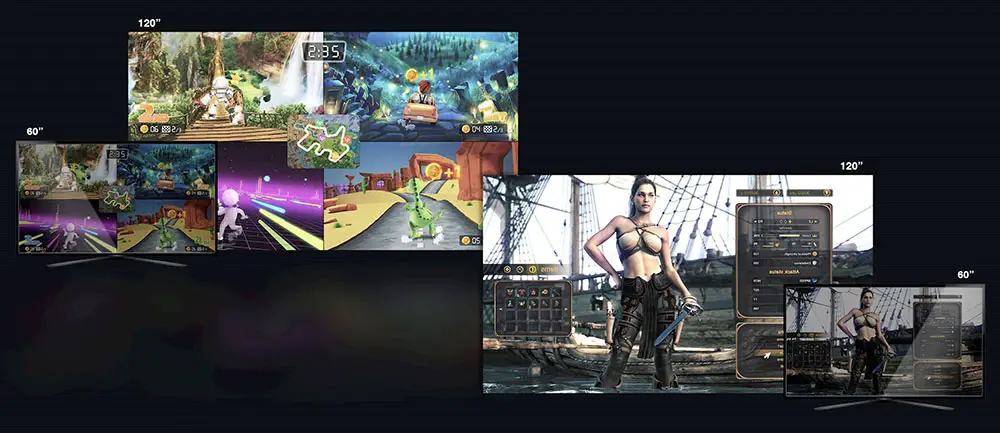
Another thing to mention here is that as with the UHD50X, the UHD30 is missing any kind of Variable Refresh Rate (VRR) technology either it be AMDs FreeSync or NVIDIA’s G-Sync which could greatly benefit the next generation of consoles to alleviate any possible screen tearing.
Now before we close this section, as we always tend to do, we connected our PS4 (No PS5 just yet!) and tried out Call of Duty WWII. The Ps4 console caps at 1080p@60Hz and in this resolution we got 24.8ms which was well within the numbers Optoma provides. No problems to be honest, as all our commands were registering very fast and there was no huge delay that could potentially affect our play.
Motion Performance
As with the UHD50X, motion performance is the number one feature that is highly advertised for the UHD30 as according to Optoma this is the first 240Hz gaming projector. But as it always happens when marketing material is involved this 240Hz refresh rate tells only half the truth.
First of all this high refresh rate can only be used with PCs as no current gaming consoles (including the PS5 and Xbox Series X) can support such a high number. The PS4 and Xbox One X have certain limitations due to the HDMI 2.0 ports they use. As such the PS4 can do 1080p@60Hz while the Xbox One X can go as high as 1080p@120Hz. The new PS5 and Xbox Series X can go as high as 4K@120Hz which is cool but there is a problem. The UHD30 cannot do such a high refresh rate in 4K resolution, only in 1080p.
So to make things slightly clearer the UHD30 projector can do a maximum of 60Hz refresh rate in 4K or it can do 60Hz, 120Hz or 240Hz in 1080p resolution. While for many this may seem a little awkward it basically is the limitations of the HDMI ports that Optoma decided to go with in the UHD30 that do not allow for anything better. The HDMI limitation is the obvious one and that’s why we mention it as we don’t know if there are other hardware limitations also other than the obvious.

But while the UHD30, along with the UHD50X which had exactly the same problem, may not be the definite gaming projector for the next generation of consoles it definitely is a glimpse of where things tend to go. Will there be a projector with HDMI 2.1 that will be capable at supporting the high refresh rates of the PS5 and Xbox Series X in 4K resolution? Definitely. It’s just a question of when but until then the UHD30 is here to cover that gap.
Ports & Connectivity
Optoma never disappointed us it terms of connectivity options and even with these low budget units you get plenty of ports in order to satisfy all needs. The UHD30 seems to offer exactly the same layout we had previously seen in the UHD50X which is even the more impressive considering the lower cost. So with everything being the same we will mention every port we find at the back of the unit starting from the left.
First there is a USB Type-A that is only being used for service, an RS-232 port, a VGA input, two HDMI inputs, a USB power output connector, a S/PDIF connector, a 12V trigger for motorized screens and two analogue 3.5mm connectors, one input and one output.
A couple of things about the HDMI inputs. The one on the left is a HDMI 2.0 which can support up to 4K@60Hz while the one on the right is an older 1.4 that can go up to 4K@30Hz. We already mentioned above about the limitations of the projector’s acclaimed 240Hz refresh rate and we should also mention that there is no HDMI 2.1 here that would be perfect for the new generation of gaming consoles. Also one more thing to notice is that the USB port can only be used to power other devices like a HDMI dongle as the projector lacks any kind of internal media player.
If there is one thing that is a bit disappointing is the limitation of the HDMI 2.0 ports. Being so close in specs to the UHD50X we were expecting this to be the case here also. Advertising this as a gaming projector is half the truth and unfortunately as it cannot do 4K@120Hz this means that you will have to sacrifice resolution in order to get the high refresh rate the projector can do for next generation consoles.
OS, Apps and Features
Last part of our review concentrates on the UI and extra features of the unit. This is another area where we find striking similarities with the UHD50X as they both feature the same UI, the same settings and the same options. No changes here either so this part of our review will also be almost similar to what we observed in the UHD50X and we will make any appropriate changes needed.
The projector is more focused on its image features and it doesn’t come with any smart functionality. Don’t forget that this is designed as a gaming projector so there was no need to add any unnecessary smart features here.
The main menu is separated in various categories depending on the purpose of each one and as such we find four main tabs in the left of the screen with Display, Audio, Setup and Info. In the Display tab you will find all the available settings and menus that has to do with image calibration like brightness, colors, contrast, aspect ratio, picture modes, display modes along with the various image technologies that Optoma has included like BrilliantColor, UltraDetail, Dynamic Black mode and obviously the Enhanced Gaming mode which is the highlight of this projector.
The Audio tab include some very basic audio settings like volume, mute and turning on/off the internal speaker, the setup tab includes options for projection placement, lamp options, power settings and maintenance while the Info tab does what it says. It display various information on the projector like general projector information, lamp hours, resolution, color settings and display modes.
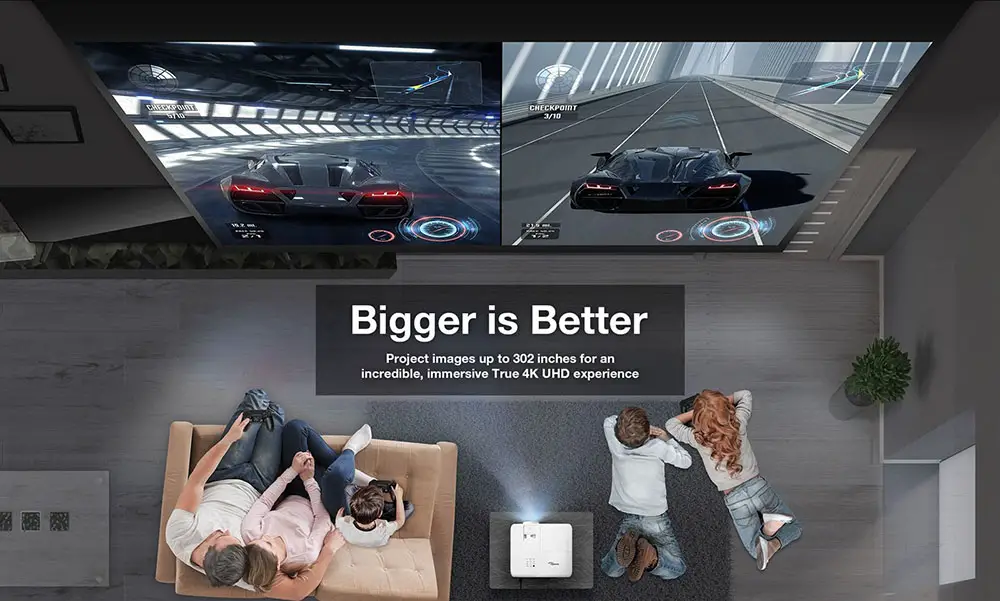
The menu layout is nothing fancy and gets the job done. But as we live in an era where visuals are of great importance we would like to see projector manufacturers offer something better than just menus that look like they belong in a previous decade.
A few notable image features included are Optoma’s UltraDetail and BrilliantColor technologies along with Dynamic Black mode. Although the UHD30 comes with many more settings and image features these three that we mentioned here are the most highlighted ones from Optoma.
As was with the UHD50X, one last feature in the UHD30 that is worth mentioning is the on-board sound. It wouldn’t be a serious gaming projector if it didn’t have on-board sound and Optoma did include a speaker for this reason. Now while many portable projectors usually go for a stereo setup the UHD30 is only featuring a single 5 watts speaker so don’t expect anything extraordinary out of it.
Obviously this can be better described as a last resort measure as the on-board speaker doesn’t have any meaningful power to create any kind of immersion. So if you have an audio system you better use that and the on-board audio should be chosen only when a better audio solution is not available.
The UHD30 is very light on extras overall. Obviously the more we can get the better value but as this is clearly marketed as a low cost gaming projector you shouldn’t expect more that could potentially make its price higher.
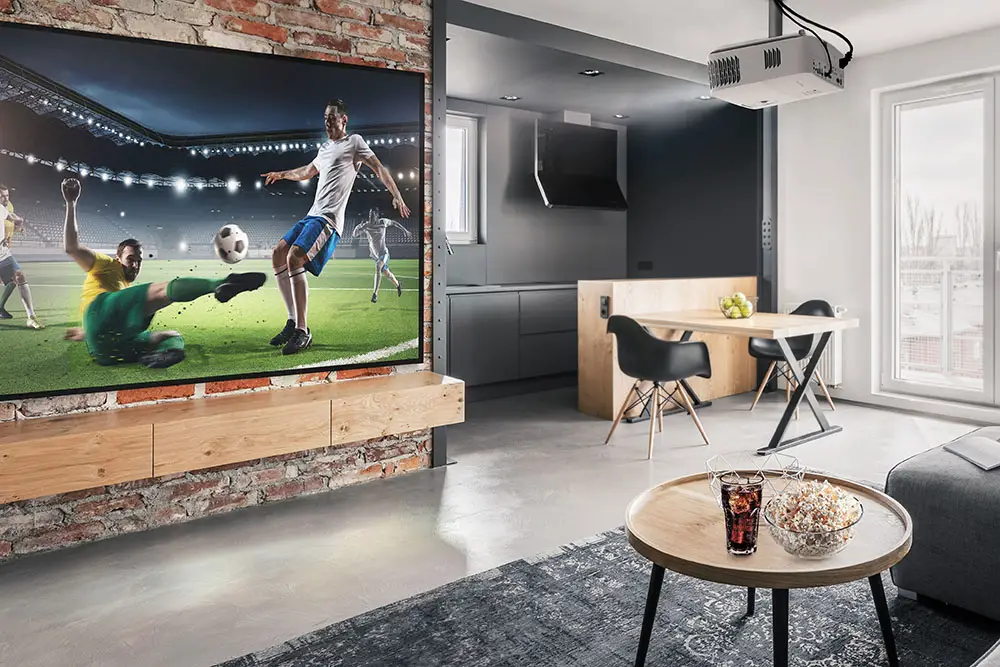
Final Thoughts
Frankly we are a bit puzzled that Optoma released two projectors with so similar specs. Many will surely be puzzled between the UHD30 and the UHD50X/UHD42 and although from our analysis their differences are obvious they are not so big to warrant two different releases.
Their differences come down to exactly three things. The UHD30 has a longer throw ratio, smaller zoom and no vertical shift. And that’s where their differences end. What this means? That for $350 less you get a projector that is highly similar to the UHD50X/UHD42 but is slightly less ideal for small rooms as it gives you less placement freedom.
In general the UHD30 has a lot going for it. Build quality is the same as the UHD50X which can be considered very good for the price asked and we are extremely fond of the backlight remote Optoma offers. 4K image quality was great with good clarity and enough definition while color performance was very good with some calibration but also good enough out of the box. Its main strength obviously was the low input lag and high refresh rate which are very important among hardcore gamers.
On the downsides the UHD30 comes with the same problems we had see in the UHD50X. HDR performance was good enough but we wouldn’t call it amazing or anything. It’s black levels are disappointing and they are more greyish than black and even with Dynamic Black enabled the image showed little improvement. Noise with 4K material was slightly higher than desirable but we wouldn’t call it all out bothering.
And obviously the much advertised 240Hz refresh rate feature. Unfortunately this applies only for 1080p resolution and not 4K. So you will have to sacrifice overall image quality if you want to use it. The projector lacks any HDMI 2.1 ports so it was obvious that it could not support both 4K resolution and such a high refresh rate at the same time. Also this high refresh rate is more meaningful for PC gamers as no console, even the new PS5 and Xbox Series X, cannot go so high.
Now as we reached the end of our review what we can say is this. If you are not so much restrained by your room dimensions and you were considering the UHD50X/UHD42 then we would advise you to reconsider. As the UHD30 is practically the same projector but with slightly less placement freedom. And this with a reduction in price of about $350. And if you consider that for $1,250 you get 4K resolution, good enough HDR, very good colors and nice gaming features we would call the Optoma UHD30 a real gaming bargain and one highly recommended.
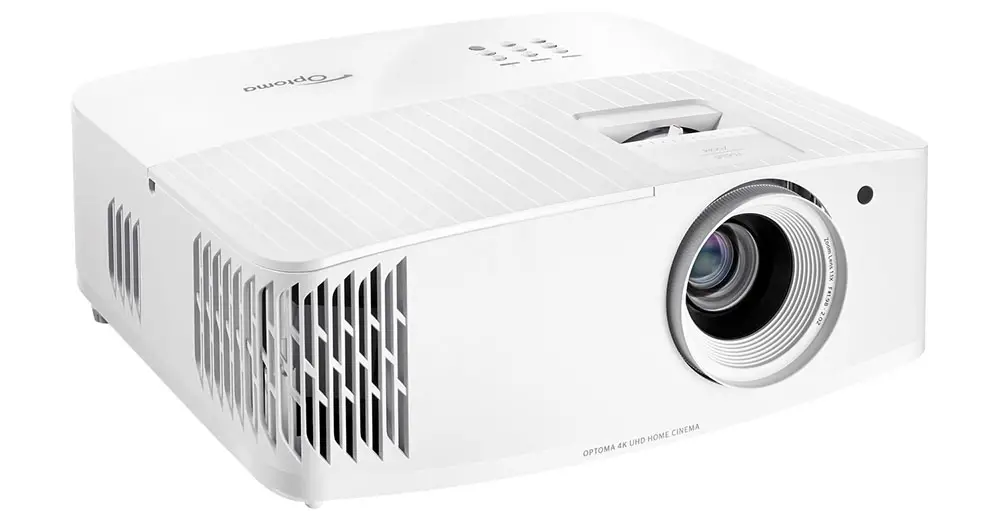
For more reviews you can check our dedicated 4K Projector reviews list or even look at our Product Reviews Table where you can find the brand and specific product you are looking for.
Cheapest Places to Buy :
*We are a reader-supported website. When you buy through links on our site, we may earn a small affiliate commission at no extra cost to you. Home Media Entertainment does not accept money for reviews.*
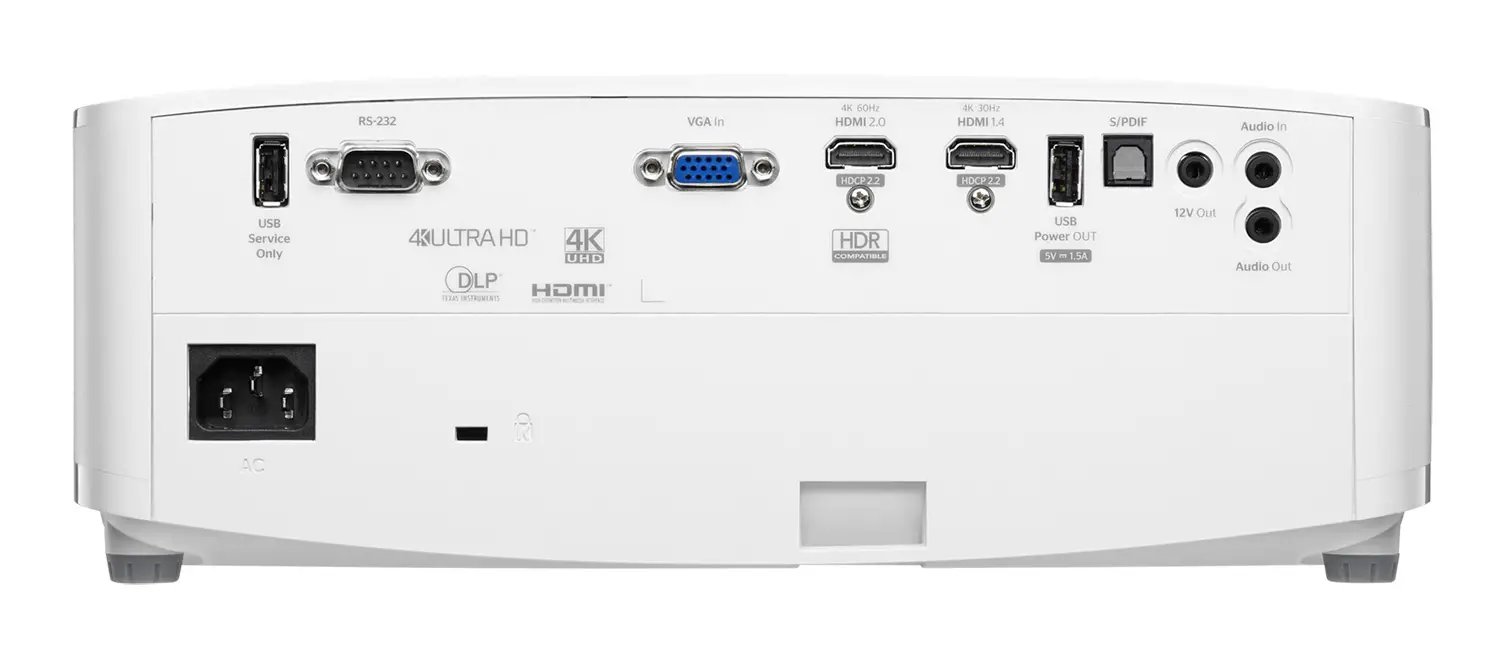
Really not a bad projector for the price. Obviously not being able to do 4K in high refresh rate is hurting it but if you don’t care much for resolution I think it’s a nice one. After all not many people will be playing at 240Hz so I don’t think this is a huge problem.
Obviously it’s not a big problem as only a minority with PC gaming in mind will be able to take advantage of this high refresh rate but for those few considering it, this will certainly make them think twice if it is worth it.
Thank you so much for this professional and detailed review. Right now we have an old projector with which our grandchildren spend their time and we were considering changing it. The UHD30 seems like a good one and not very expensive. Will certainly give it a closer look as it is not easy to find a gaming projector at this price range.
Yes at this price range you cannot really do much better when it comes to gaming projectors. It is really worth a look.
Thanks for bringing this detailed and comprehensive review of the Optoma UHD30. I also find it strange how Optoma decided to release 2 models with so close specs to each other. It doesn’t make much sense to be honest. I was looking at the UHD50X the other day and that one looked very nice. If the UHD30 is so similar for $350 less then it’s a steal really.
Hey Geoff. If you are not limited by space then the UHD30 is really the better choice as you get practically the same projector. I would suggest the UHD50X only if you have a small room and you need more placement freedom.